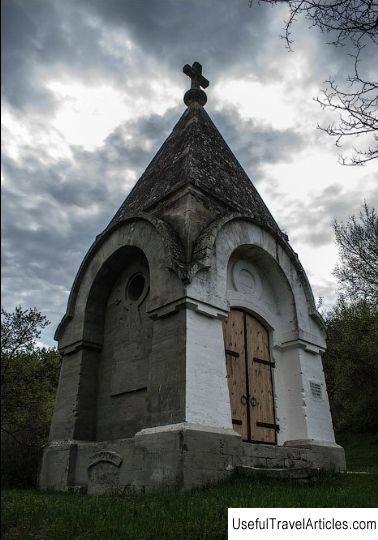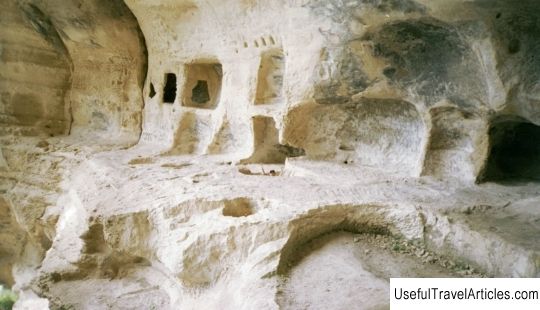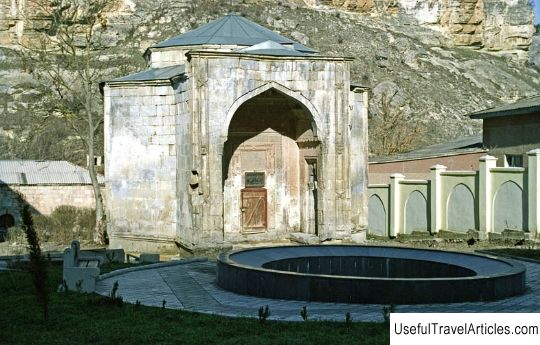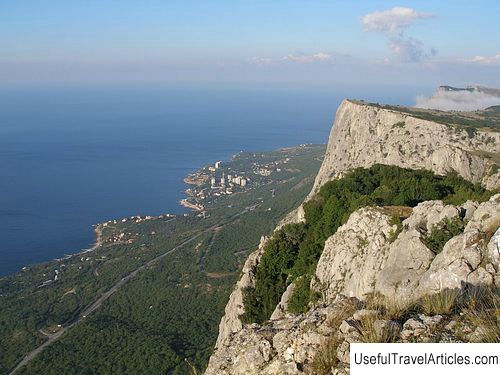Assumption cave monastery description and photos - Crimea: Bakhchisarai
Rating: 8,0/10 (403 votes) 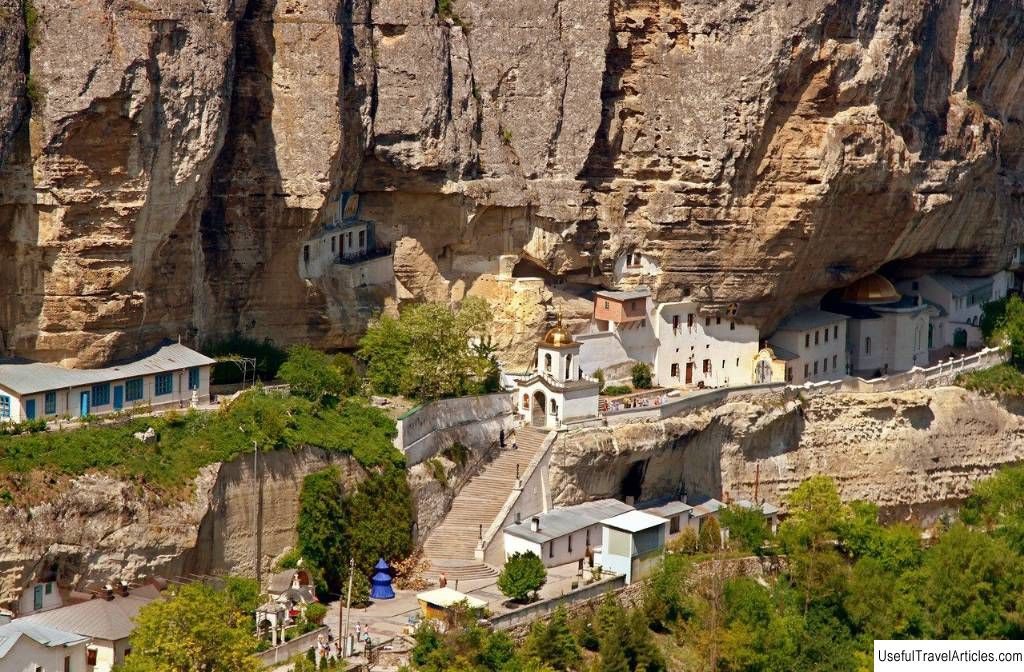
Assumption cave monastery description and photos - Crimea: Bakhchisarai. Detailed information about the attraction. Description, photos and a map showing the nearest significant objects. Photo and descriptionThe picturesque cave monastery, which many call "Crimean Athos" is located in a gorge not far from Bakhchisarai. This is one of the main shrines of the peninsula, a fertile and amazingly beautiful place. History of the monasteryNobody knows the exact date of the foundation of the monastery. It is located in a rocky area, in the Mariam-Dere gorge . People have lived in these soft limestone rocks for a long time. There are also cave cities - Bakla and Chufut-Kale, and monasteries. Tradition connects the appearance of the first temples in these places with the fact that icon-worshipers fled here from Byzantium. In the 8th-9th centuries, an iconoclastic movement arose in Byzantium, which was periodically supported by the emperors themselves. So, in the VIII century, by decree of Emperor Leo the Isaurian it was expressly forbidden to venerate icons. Images sacred to many were destroyed, confiscated and spoiled. Admirers of icons fled from persecution to remote places - for example, to the Crimean mountains, to the far northern outskirts of the empire. In any case, the first cave church of the monastery appeared just then. But over time, the place was abandoned. The monastery, known to us from historical sources, appeared here already in the 15th century. Legends associate the foundation of the monastery with the miraculous finding of the icon . A shepherd passing by saw an icon of the Mother of God high on a rock and took it out, but the icon mysteriously returned to its place. Then it became clear that there is a temple there, and God wants a monastery to be founded. According to another - more fabulous - legend, a terrible snake settled in the mountains, which devoured people. The surrounding population prayed to the Mother of God for help - and soon help came. People found a cave in the mountains, in it a dead monster, and the icon of Hodegetria . One way or another, the monastery, located not far from the new capital of the Crimean Khanate, Bakhchisarai, has become the main monastery for Christians trapped in a Muslim environment and subjected to various harassment. However, while the Khanate remained independent, the Christians were treated well here, but after the Khanate fell under the protectorate of the Ottoman Empire , their life deteriorated significantly. There were only four monasteries left in the whole Crimea - Holy Dormition became one of them. Ignatius of MariupolThe brightest page in the history of the monastery in the 18th century is the stay of Metropolitan Ignatius , who is now canonized as Saint Ignatius of Mariupol . A Greek by birth, a very educated and moral person, he was appointed Metropolitan here in 1771. Arriving in Crimea, the saint saw numerous oppression of the Christian population: unbearable taxes, powerlessness and humiliation. The time of his reign fell on the period of the Russian-Turkish war. On the territory of the Crimea, hostilities were fought, at Perekop, at Kerch, battles took place. Peace was finally concluded in 1774. According to him, the Crimean Khanate received independence from both the Ottoman Empire and Russia. The Russian protege Shahin-Girey became the Khan, but this did not help the Christian population. Khan was distinguished by cruelty, and uprisings immediately began against him. The country was plunging into turmoil. Then the saint turned to Russia for help. He asked Empress Catherine II to help Crimean Christians move to new lands and accept Russian citizenship. The Empress agreed to help. Considerable funds were allocated for the "exodus", the settlers were promised land in the southern provinces and exemption from taxes and recruitment for ten years. The Metropolitan and his people secretly began to inform Christians about the impending resettlement. And on Easter 1778, after a service in the cave church of the Assumption, he officially announced its beginning. They bought off the khan with rich gifts, and he himself allocated a guard for those who left. In total, more than thirty thousand people left Crimea - mostly Greek and Armenian Christians. They were the ones who founded the city Mariupol . The Metropolitan took with him the main shrine of the monastery - the Hodegetria icon. Before the revolution, it was kept in the Kharlampievsky Cathedral, and then it was lost. Ignatius himself died in 1786, and in 1997 he was officially canonized by the Orthodox Church. His icons are now in the Assumption Monastery. Monastery in the 19th century But the story of this place did not end there. Many Christians remained in Crimea: some could not leave their homes and lands, others hoped for an early reunification with Russia. The monastery itself ceased to function, but The Assumption Church remained in operation and turned into just a parish church. For a long time it was the only church on a fairly large territory. After the transition of Crimea to Russia, many Orthodox Christians again appeared here, only now they were not local Greeks, but Russian soldiers of the surrounding garrisons. The temple began to receive rich donations. The head of the Bakhchisarai garrison Colonel Totovich helped to renew the iconostasis and donated the icon of the Assumption of the Virgin - it became a temple. The ruler of the Tauride region Vasily Kakhovsky made new royal gates with his own money. In 1818, during his trip across the peninsula, Emperor Alexander I came here and also made a rich donation. The second time he made a pilgrimage to the Crimean monasteries just before his death in 1825. In 1837, the heir to the throne came - the future Emperor Alexander II . In the middle of the century, the monastery itself was revived. In 1850, after a solemn, crowded divine service, the restoration of the Assumption Skete was announced. During the Crimean War, a hospital was located here. Soldiers and officers from besieged Sevastopol were brought here. Those who could not be saved were buried in the monastery cemetery. In 1875, a small church was built next to this necropolis, dedicated to the patron saint of warriors - St. George . Funds for its construction were allocated by General G. I. Perovsky. In 1896, St. Innokenty of Irkutsk . It was built in honor of the patron saint of another Innocent - the Kherson and Tauride archbishop, the famous preacher Innocent (Borisov). He was canonized already in the 20th century at the same time as Ignatius of Mariupolsk. The monastery grew and developed. At the end of the 20th century, there were five churches, a refectory, a bell tower, an abbot's house and two hotels . The monks lived in cave cells carved into the rock. In the rock, a water pipe was cut, water into which came from underground sources: in the monastery under the rock there was even a fountain. The royal family came here many times, the last time Nicholas II was here in 1913. Four years after the revolution, in 1921, the monastery was closed, and all valuables were confiscated. Part was destroyed some of them ended up in the Bakhchisarai Museum. A labor colony was formed in this place. Most of the buildings were dismantled, only the cave cells, the Assumption Church and the refectory were preserved. During the Great Patriotic War, there was again a hospital here, and in the postwar years there was a neuropsychiatric clinic . In our time The revival of the ancient monastery began in 1992 . A part of the territory was returned to the monastery, farm buildings were restored, and most importantly - cave temples. Many now call this place "Crimean Lavra" or even "Crimean Athos", that is, the main monastery of the peninsula. Now here three churches - Holy Dormition, St. Constantine and Helena and St. ap. Mark. The place where the Hodegetria icon once appeared is marked by a balcony with a beautiful view of the surrounding area. The decoration of the monastery became images carved directly into the rock - for example, the entrance to the Assumption Church is marked by a huge figure of a seraphim with six wings. The iconostasis in it is also made of white carved stone. Surprisingly, despite the fact that the church is located in a cave, it is filled with bright light coming from a high balcony. A revered icon is kept in a separate niche - a copy of the one that appeared here in the 15th century. Festive services are performed in the Dormition Church, and for everyday ones they descend into another temple dedicated to the Evangelist Mark. It is already truly "caveman" - there are no windows in it. The monks no longer live in caves - new brotherly buildings and a hotel have been built below the rock. The hotel is small, so that large groups of pilgrims are often accommodated for the night right in the temples. Above the source there is a chapel with the icon of the Virgin Mary "Life-giving source" . a functioning monastery , so there are some restrictions to consider when visiting. Here they are asked not to use cell phones or take pictures, short and open summer clothes are not allowed, women must be covered. Excursions here are conducted by the monks themselves. Access to a number of Muslim shrines on the territory of Chufut-Kale (Zyndzhyrly madrasah and Muslim cemetery) is possible only through the Holy Dormition Monastery. In the mid-2000s, a critical situation arose associated with the dissatisfaction of the local Islamic population with the activities of the Orthodox monastery. There were even several attacks on the monastery and it had to be taken under guard. Then the abbot proposed to build a special gate with Islamic symbols for Muslims at the expense of the monastery. However, even now the conflict between the monastery and the Crimean Tatar community has not been fully exhausted. The monastery sometimes hosts services not only in Church Slavonic, but also in the Crimean Tatar language.           We also recommend reading Gomel State Circus description and photos - Belarus: Gomel Topic: Assumption cave monastery description and photos - Crimea: Bakhchisarai. |
